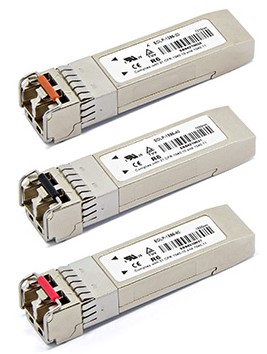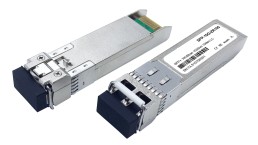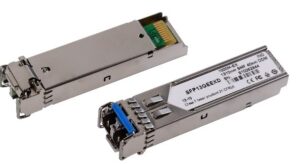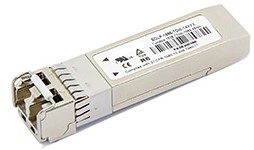10Gbps 1310nm 10km SFP+ Transceiver
Model/PN: NASASFPP1310GLR
Product Features
- • Up to 10Gbps data links
- • 10km with 9/125µm SMF
- • 1310nm DFB laser
- • Duplex LC Connector
- • Hot-pluggable SFP+ footprint
- • Single 3.3V power supply
- • Operating temperature: -40℃ to 85℃
- • All-metal housing for superior EMI performance
- • Digital Diagnostic Monitor compatible
- • BER ≤ 10-12
Applications
- • 10GBase-LR/LW
- • 1200-SM-LL-L 10G FC
Standards
- • Compliant to SFF-8431, SFF-8432, SFF-8472
- • Compliant to IEC61000-4-3, EN 60825, EN 60950
- • Compliant to IEEE 802.3ae 10GBASE-LR
- • RoHS Compliant
1. Product Description
The NASASFPP1310GLR is a 10Gbps enhanced small form factor pluggable SFP+ transceiver module is individually tested on a series of Cisco, Juniper, Dell, HP, IBM, Nokia, Huawei, ZTE…. switches, routers, servers, network interface card (NICs) etc., and is fully compatible with 10GBASE-LR/LW and 10G Fiber Channel 1200-SM-LL-L. It is suitable for single-mode fiber (SMF) communications in 10Gbps Ethernet and 10G Fiber Channel.
The SFP+ LR module electrical interface is compliant to SFI electrical specifications. The transmitter input and receiver output impedance is 100 Ohms differential. Data lines are internally AC coupled. The module provides differential termination and reduce differential to common mode conversion for quality signal termination and low EMI. SFI typically operates over 200 mm of improved FR4 material or up to about 150mm of standard FR4 with one connector.
In the transmit direction, the SFP+ transceiver module receives a 10 Gbps electrical signal (signaling rate) from the host board Asic/SerDes and converts the data to an optical signal via the Laser Driver that controls the Laser diode in the Transmitter Optical Sub-Assembly (TOSA). An open collector compatible Transmit Disable (Tx_Dis) is provided. A logic “1,” or no connection on this pin will disable the laser from transmitting. A logic “0” on this pin provides normal operation. The transmitter has an internal automatic power control loop (APC) to ensure constant optical power output across supply voltage and temperature variations. An open collector compatible Transmit Fault (TFault) is provided. TX_Fault is a module output contact that when high, indicates that the module transmitter has detected a fault condition related to laser operation or safety. The TX_Fault output contact is an open drain/collector and shall be pulled up to the Vcc_Host in the host with a resistor in the range 4.7-10 kΩ. TX_Disable is a module input contact. When TX_Disable is asserted high or left open, the SFP+ module transmitter output shall be turned off. This contact shall be pulled up to VccT with a 4.7 kΩ to 10 kΩ resistor.
The receiver converts 10 Gbps serial optical data into serial PECL/CML electrical data. An open collector compatible Loss of Signal is provided. Rx_LOS when high indicates an optical signal level below that specified in the relevant standard. The Rx_LOS contact is an open drain/collector output and shall be pulled up to Vcc_Host in the host with a resistor in the range 4.7-10 kΩ, or with an active termination. Power supply filtering is recommended for both the transmitter and receiver. The Rx_LOS signal is intended as a preliminary indication to the system in which the SFP+ is installed that the received signal strength is below the specified range. Such an indication typically points to non-installed cables, broken cables, or a disabled, failing or a powered off transmitter at the far end of the cable.
The 3rd functional capability of the SFP+ module is the 2 wire serial, I2C, interface. I2C is used for serial ID, digital diagnostics, and module control functions. The enhanced digital diagnostics monitoring interface allows real time access to the device allowing monitor of received optical power, laser bias current, laser optical output power, etc.

Figure 1: Interface to Host
2. Regulatory Compliance
NASA-SI transceivers are Class 1 Laser Products comply with FDA regulations. Meet Class 1 eye safety requirements of EN 60825 and the electrical safety requirements of EN 60950.
3. Absolute Maximum Rating
These values represent the damage threshold of the module. Stress in excess of any of the individual Absolute Maximum Ratings can cause immediate catastrophic damage to the module even if all other parameters are within Recommended Operating Conditions.
|
Parameter |
Symbol |
Min. |
Max. |
Unit |
|
Supply Voltage |
Vcc |
0 |
+3.6 |
V |
|
Storage Temperature |
Ts |
-40 |
+85 |
°C |
|
Operating Case Temperature |
Tc |
-40 |
+85 |
°C |
|
Relative Humidity |
RH |
5 |
95 |
% |
|
RX Input Average Power |
Pmax |
– |
0 |
dBm |
4. Recommended Operating Conditions
|
Parameter |
Symbol |
Min. |
Typical |
Max. |
Unit |
|
Operating Case Temperature |
Tc |
-40 |
|
85 |
°C |
|
Power Supply Voltage |
Vcc |
3.135 |
3.3 |
3.4565 |
V |
|
Power Supply Current |
Icc |
|
|
200 |
mA |
|
Data Rate |
|
9.95 |
10 |
10.5 |
Gbps |
|
Max Link Length on 9/125µm SMF |
Lmax |
|
10 |
|
km |
5. Optical Characteristics
|
Parameter |
Symbol |
Min. |
Typical |
Max. |
Unit |
Note |
|
Transmitter |
|
|||||
|
Center Wavelength |
λc |
1260 |
1310 |
1355 |
nm |
|
|
Side Mode Suppression Ratio |
SMSR |
30 |
|
|
dB |
|
|
Output Power |
Pout |
-8.2 |
|
0.5 |
dBm |
Note 1 |
|
Transmitter and dispersion penalty |
Pp |
|
0 |
|
dB |
Note 4 |
|
Average output power of OFF transmitter |
Poff |
|
|
-30 |
dBm |
|
|
Extinction Ratio |
ER |
3.5 |
|
|
dB |
Note 2 |
|
RIN12 OMA |
RIN |
|
|
-128 |
dB/Hz |
|
|
Optical Return Loss Tolerance |
ORL |
12 |
|
|
dB |
|
|
Receiver |
|
|||||
|
Centre Wavelength |
λc |
1260 |
1310 |
1355 |
nm |
|
|
Receive Overload |
Pmax |
|
|
0.5 |
dBm |
|
|
Receiver Sensitivity |
PIN |
-14.5 |
|
|
dBm |
Note 3 |
|
Receiver Sensitivity in OMA |
POMA |
|
|
-12.6 |
dBm |
Note 3 |
|
Receiver Reflectance |
PREF |
|
|
-12 |
dBm |
|
|
Stressed Receiver Sensitivity in OMA |
PSTR |
|
|
-10.3 |
dBm |
|
|
Vertical eye closure penalty |
|
2.2 |
|
|
dB |
|
|
Stressed eye jitter |
|
0.7 |
|
|
Ulp-p |
|
|
Receive electrical 3dB upper cutoff frequency |
|
|
|
12.3 |
GHz |
|
|
Receiver power (damage, Max) |
PDAM |
|
|
1.5 |
dBm |
|
Notes:
- The optical power in launched into SMF
- Measured with a PRBS 231-1 test pattern @ 10.3125 Gbps
- Measured with a PRBS 231-1 test pattern @ 10.3125 Gbps BER ≤ 10-12
- In G.652 and G.655 (NDSF)
6. Electrical Characteristics
|
Parameter |
Symbol |
Min. |
Typical |
Max. |
Unit |
|
Data rate |
|
9.95 |
10 |
10.5 |
Gbps |
|
Power Consumption |
|
|
1200 |
1500 |
mW |
|
Transmitter |
|||||
|
Single Ended Output Voltage Tolerance |
|
-0.3 |
|
4.0 |
V |
|
C common mode voltage tolerance |
|
15 |
|
|
mV |
|
Tx Input Diff Voltage |
VI |
400 |
|
1600 |
mV |
|
Tx Fault (at 0.7mA) |
VoL |
-0.3 |
|
0.4 |
V |
|
Data Dependent Input Jitter |
DDJ |
|
|
0.10 |
UI |
|
Data Input Total Jitter |
TJ |
|
|
0.28 |
UI |
|
Receiver |
|||||
|
Single Ended Output Voltage Tolerance |
|
-0.3 |
|
4.0 |
V |
|
Rx Output Diff Voltage |
Vo |
300 |
|
850 |
mV |
|
Rx Output Rise and Fall Time (20% to 80%) |
Tr/Tf |
30 |
|
|
ps |
|
Total Jitter |
TJ |
|
|
0.70 |
UI |
|
Deterministic Jitter |
DJ |
|
|
0.42 |
UI |
7. Pin Description
The SFP+ modules are hot-pluggable. Hot pluggable refers to plugging in or unplugging a module while the host board is powered. The SFP+ host connector is a 0.8 mm pitch 20 position right angle improved connector specified by SFF-8083, or stacked connector with equivalent with equivalent electrical performance. Host PCB contact assignment is shown in Figure 2 and contact definitions are given in SFP+ Module PIN Definition Table. SFP+ module contacts mates with the host in the order of ground, power, followed by signal as illustrated by Figure 3 and the contact sequence order listed in SFP+ Module PIN Definition Table.
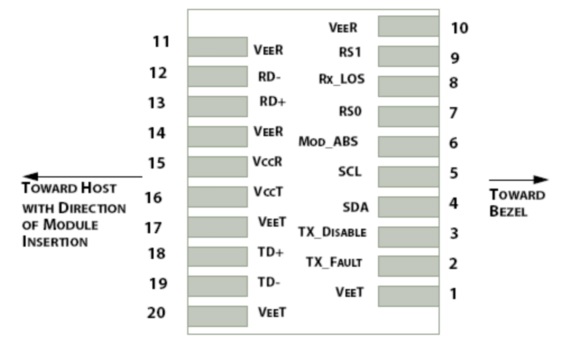
Figure 2: Interface to Host PCB

Figure 3: Module Contact
|
Pin |
Symbol |
Description |
Note |
|
1 |
VeeT |
Module Transmitter Ground |
Note 1 |
|
2 |
TX_Fault |
Module Transmitter Fault |
|
|
3 |
TX_Disable |
Transmitter Disable, Turn off transmitter lase output |
Note 2 |
|
4 |
SDA |
2-wire Serial Interface Data Line (Same as MOD-DEF2 in the INF-8074i) |
Note 3 |
|
5 |
SCL |
2-wire Serial Interface Clock (Same as MOD-DEF1 in the INF-8074i) |
Note 3 |
|
6 |
Mod_ABS |
Module Absent, connected to VeeT or VeeR in the module |
Note 3 |
|
7 |
RS0 |
Rate Select 0, optionally controls SFP+ module receiver. When high input signaling rate >4.25 GBd and when low input signaling rate <4.25GBd |
|
|
8 |
Rx_LOS |
Receiver Loss of Signal Indication (In FC designated as Rx_LOS and in Ethernet designated as Signal Detect. |
Note 4 |
|
9 |
RS1 |
Rate Select 1, optionally controls SFP+ module transmitter. When high input signaling rate >4.25 GBd and when low input signaling rate <4.25GBd |
|
|
10 |
VeeR |
Module Receiver Ground |
Note 1 |
|
11 |
VeeR |
Module Receiver Ground |
Note 1 |
|
12 |
RD- |
Receiver Inverted DATA output |
|
|
13 |
RD+ |
Receiver Non-inverted DATA output |
|
|
14 |
VeeR |
Module Receiver Ground |
Note 1 |
|
15 |
VccR |
Module Receiver 3.3V Supply |
|
|
16 |
VccT |
Module Transmitter 3.3V Supply |
|
|
17 |
VeeT |
Module Transmitter Ground |
Note 1 |
|
18 |
TD+ |
Transmitter Non-Inverted DATA input |
|
|
19 |
TD- |
Transmitter Inverted DATA input |
|
|
20 |
VeeT |
Module Transmitter Ground |
Note 1 |
Notes:
- Circuit ground is internally isolated from chassis ground.
- Laser output disabled on Tx_Disable >2.0V or open, enabled on Tx_Disable <0.8V.
- Should be pulled up with 4.7k – 10kohms on host board to a voltage between 2.0V and 3.6V. Mod_ABS) pulls line low to indicate module is plugged in.
- LOS is open collector output. Should be pulled up with 4.7k -10kohms on host board to a voltage between 2.0V and 3.6V. Logic 0 indicates normal operation; logic 1 indicates loss of signal.
8. Mechanical Specifications

9. LABEL
NASA-SI offers label OEM design and print.
Label barcode supports code128 and 2D barcode
SIZE: 1) Front 35mm*10.5mm 2) Back 26mm*10.5mm
Ordering Information
|
Part No. |
Data Rate |
DDM |
Wave |
Fiber Type |
Dist. |
Temp. |
Optical Interface |
|
NASASFPP1310GLR |
10Gbps |
yes |
1310nm |
SMF |
10km |
-40~85℃ |
LC |

